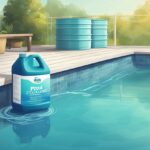Maintaining a sparkling clean swimming pool can be simple when you use the right materials. Calcium hypochlorite, a popular choice for pool maintenance, stands out for its effectiveness as a pool shock. When you’re aiming for a pristine swimming environment, the purity and sanitation of your pool water are paramount. With calcium hypochlorite, you have a powerful ally that ensures your pool remains a safe and enjoyable place for everyone.

Shocking your pool on a regular basis is crucial to combat contaminants that regular chlorination might miss. Calcium hypochlorite shines in this regard, as it’s formulated to tackle a wide array of organic and inorganic impurities. It’s a strong and fast-acting chemical, known for its high chlorine content, which is why you won’t need to use as much of it to achieve the desired chlorine levels in your swimming pool.
The benefits of using calcium hypochlorite for pool shock treatments go beyond its potency. It’s an ideal choice to apply at night, due to its composition of unstabilised chlorine that’s less susceptible to UV degradation. By incorporating calcium hypochlorite into your pool maintenance routine cautiously and according to guidelines, you will be able to sustain a consistently clean and inviting pool.
The Benefits of Calcium Hypochlorite as a Pool Shock
Calcium hypochlorite, commonly referred to as cal hypo, is renowned as a highly effective chemical for maintaining a clean and safe swimming environment. As you explore the advantages of using calcium hypochlorite for pool maintenance, you’ll learn its impact on everything from water chemistry to safety protocols.
Effective Disinfectant Properties
Cal hypo is a potent disinfectant that kills off bacteria, microbes, and algae in your pool water. This compound contains a high concentration of available chlorine, typically between 65% and 75%, making it more effective against contaminants compared to other forms of chlorine. Regular use ensures that your pool remains sanitized and free from harmful organisms that can pose health risks.
Keeping Chlorine Levels Balanced
Maintaining the appropriate free chlorine levels is vital for a hygienic pool. Cal hypo helps sustain a balanced amount of free chlorine, combatting the formation of chloramines and keeping the total chlorine level within the ideal range. This balance is crucial for the effectiveness of chlorine as a disinfectant and for swimmer comfort.
Impact on Water Chemistry
Cal hypo has a minimal impact on your pool’s pH level compared to some other shock treatments, which helps maintain stable water chemistry. However, it does slightly increase the water’s calcium hardness levels, which should be monitored with a testing kit to prevent scaling. Your pool’s alkalinity, cyanuric acid levels, and overall water chemistry should be regularly tested and adjusted as necessary.
Ease of Use and Safety Considerations
Though a granular chemical, cal hypo is relatively simple to use. Pre-dissolving the granules in a bucket of pool water before application ensures an even distribution without harming your pool’s liner or finish. When handling cal hypo, it’s important to wear safety goggles, a long-sleeve shirt, and chemical-resistant gloves to protect yourself from potential hazards. Always follow dosage instructions carefully to avoid over-shocking.
Calcium Hypochlorite vs. Other Shock Treatments
When compared to other shock treatments like sodium hypochlorite (liquid chlorine) and chlorine tablets, cal hypo stands out for its higher available chlorine content. It is stable in sunlight, which helps prolong its disinfecting action, and it doesn’t introduce additional cyanuric acid to the water, unlike chlorine tablets. This makes it a preferable choice for routine shock treatments and heavily used pools.
Practical Tips for Using Calcium Hypochlorite

When choosing calcium hypochlorite to shock your swimming pool, understanding the correct procedures and optimal conditions ensures effective sanitisation without causing damage to the pool or discomfort to swimmers.
Optimal Conditions for Shocking a Pool
To maximise the effect of calcium hypochlorite, shock your pool under certain conditions. Firstly, shocking should be done at dusk or during the evening to prevent sunlight from degrading the chlorine levels too quickly. Secondly, ensure the pool’s pH level is between 7.2 and 7.6 to enhance the efficiency of the chemical. Lastly, consider the cyanuric acid level, which should be balanced to properly stabilise the chlorine, particularly if the pool is exposed to high sunlight.
How to Properly Shock Your Pool
Mixing and applying calcium hypochlorite correctly is crucial in avoiding pool damage:
- Calculate Pool Volume: Determine your swimming pool size in litres to estimate the required amount of pool shock.
- Dissolve the Shock: Fill a 5-gallon bucket halfway with warm water and slowly add the calcium hypochlorite. Use a wooden stir stick to mix until fully dissolved.
- Pour It In: Evenly distribute the solution around the pool’s perimeter, focusing on areas with minimal water flow to ensure thorough distribution.
During this process, wearing protective clothing and eye gear is recommended to protect against potential splashes of the chemical solution.
Maintenance Strategies for Pool Owners
After shocking, proper maintenance is the key to keeping your pool in top condition:
- Regular Testing: Consistently test water for sanitizer level, pH, and cyanuric acid to ensure the pool remains balanced.
- Prompt Cleaning: Remove contaminants such as algae growth, sunscreens, bodily fluids, and debris regularly.
- Post-Event Care: Following heavy pool use, such as after a pool party, or after environmental changes like rain or a storm, perform an additional shock treatment.
By adhering to these straightforward steps, you can maintain a clean and enjoyable swimming environment while managing the levels of calcium hypochlorite in your pool effectively.











